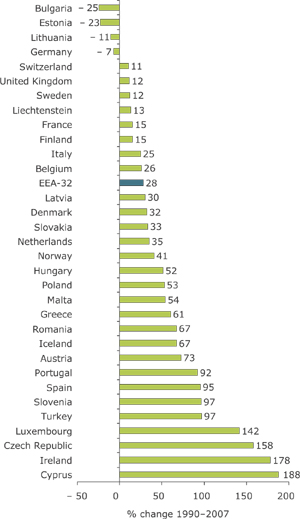Raising the toll on the transport sector
on
Raising the toll on the transport sector
The European energy industry has long complained about the ‘easy ride’ given to the transport sector by European Union lawmakers. Transport is a big emitter of greenhouse gases and the energy industry feels that the burden of EU climate policy should be fairly distributed. As European Commission President José Manuel Barroso has made greening the transport sector one of the main priorities for his second mandate, one can expect that the sector will finally start to pay a higher toll. However, for politicians the holy motor car is a much more difficult target than “dirty” power plants. EER takes stock of Brussels’ transport policy.
 |
The Commission made a key move in late April by publishing a ‘European strategy on clean and energy-efficient vehicles’. It encourages the modernisation of vehicles, investments in research and fostering incentives for the market uptake of new technologies, including electric cars. It also sets out plans to reduce the emissions of vans, lorries and coaches. The strategy was underpinned by the simultaneous publication of a report called ‘Towards a resource-efficient transport system’ from the European Environment Agency (EEA), the EU’s dedicated body for environmental indicators and statistics. The EEA report points to the lack of improvement in reducing emissions from the EU’s transport sector and calls for urgent action.
Environmentally virtuous
The EU took its first cautious steps towards the transport sector in late 2008, when it adopted measures to improve fuel quality and car emission standards as part of its energy and climate package. EU leaders set a binding target for renewable energy sources to account for 10% of energy in transport by 2020. Earlier in 2008, the EU had agreed to include aviation sector emissions in the EU emission trading scheme (ETS) from 2012. The inclusion of emissions from the shipping industry is still under discussion.
These measures were met with much resistance. At the global level, the International Civil Aviation Organisation (ICAO) and the International Maritime Organisation (IMO) are reluctant to subject their sectors to a cap-and-trade scheme to curb emissions. In the EU the car industry waged a fierce lobbying battle against emission standards for passenger cars. Members of the European Parliament, European Commission officials and EU Ministers were sharply divided on the issue. In the end, the Commission settled for a compromise.
In June 2009 the Commission published a strategic paper entitled ‘A sustainable future for transport’, in which it recognized that ‘the environment remains the main policy area where further improvements are necessary’. This was confirmed at a global level, as the debate at the Copenhagen climate summit showed that ‘practically all countries recognise that transport emissions must be addressed as part of the broader efforts to mitigate climate challenge’, as the EEA report puts it. ‘Transport represents, if not a low hanging fruit, at least one that may have to be picked,’ it says.
However, the measures taken so far are not enough to set the transport sector on an environmentally virtuous path. Indeed, transport emissions are growing at a faster rate than economic growth. The Commission is now looking for new ways to tackle the issue. This year it created a separate Department dedicated to climate action, headed by former Danish Environment Minister Connie Hedegaard. Hedegaard is now working on a ‘transport and climate’ legislative package due to be published next year.
| Change in total GHG emissions from transport |
 |
| Despite great improvements in car efficiency, greenhouse gas emissions from transport have significantly icreased in the period from 1990 - 2007, because of the great expansion of our car fleet. |
Supply side measures
Yet is well-known that anything to do with transport is highly sensitive politically. Voters tend to object strongly to any restrictions on their car use. A recent report from the Smith School of Enterprise and the Environment from the University of Oxford notes: ‘Economic activity and, consequently, societal welfare are intrinsically linked to the mobility of humans and the transportation of goods.’ The ‘Future of Mobility Roadmap’ published by the Smith School of Enterprise is the final report of the Shell-sponsored ‘Future of Mobility horizon-scanning project’, edited by the well-respected Sir David King, a former scientific adviser to Tony Blair and Gordon Brown (see this video interview). Its basic message is that more prosperity, more trade, more globalisation and more leisure all translate into more transport. As a result, ‘reducing emissions from the transport sector by reducing mobility will have dire consequences for the global economy’, the report concludes. The challenge, therefore, is to cut transport emissions ‘while enhancing human mobility’.
The transport industry is of course also an essential industrial sector for Europe, accounting for around 12 million jobs and 5% of Europe’s GDP. These national industrial interests explain why the EU’s environmental policies with regard to transport tend to focus on the supply side rather than the demand side. The idea is to encourage the replacement of existing and future vehicles with greener versions without affecting our consumption patterns, i.e. our mobility habits. Climate policies are framed as an industrial opportunity.
The European Commission says this openly in its new clean vehicles paper: ‘The European car industry is slowly recovering from an economic crisis. Clean and efficient technologies are an opportunity to recreate and reinvent Europe’s position as market leader and technological champion’. The EU acknowledges that the European car industry has to compete with the Americans and Asians, who are investing large sums of money into low-carbon technologies. An added advantage of the introduction of electric cars is that it will allow EU member states that are reluctant to boost biofuels consumption to allow them to meet their 10% renewable energy target in transport fuels by 2020.
During their meeting on 25 May 2010, EU Research Ministers strongly backed the Commission's strategy for clean vehicles, and in particular its accompanying short-term action plan for electric cars (see box). About the hydrogen fuel cell car they said this will be for the medium term, ‘as affordability of the car and availability of the fuel is achieved’.
With the EU move for electric cars, ‘a taboo has been broken, that of European sectoral initiatives,’ a Brussels-based diplomat told EER. He was delighted that the EU is capable of launching a genuine European industrial policy through big European technology initiatives which can be backed by all EU member states, such as the electric car. Usually the most liberal EU member states point to the necessity for EU initiatives to be ‘technology neutral’ in order not to favour any particular industry and interfere with the free market.
Alternative fuels
In the meantime the one area in which the EU did set firm targets – namely in fuel substitution – a huge controversy has broken out, namely over the desirability of biofuels. In the framework of EU transparency law, the European Commission has recently been forced by Reuters to release an annex to a study on the impact of biofuels policy that it had withheld up until now. The report, compiled by the Fraunhofer Research Institute in Germany, points out that many biofuels are inferior to conventional fuels in terms of their carbon footprint. The NGO Transport and Environment (T&E) noted that, ‘for the third time in six weeks, the Commission has been forced to release studies about the climate effects of biofuels and for the third time these studies show that land use is the most important factor in determining if biofuels make sense or not’. The methodology for determining the carbon footprint of fuels has always been controversial and the debate is far from over.
According to the EEA, currently ‘only a few countries are on track to meet the 2010 indicative targets for biofuel use’. The controversy over biofuels provides opportunities for suppliers of other alternative fuels. The industries producing synthetic fuels such as BTL (Biomass-To-Liquid), GTL (Gas-To-Liquid) and HVO (Hydrotreated Vegetable Oil) have already started lobbying campaigns in Brussels, vaunting their greenhouse gas emission and air quality benefits. As the next EU multi-annual budget (post-2013) will fully take account of the policy priorities set by the 2050 scenarios for energy and transport, the fuel industry is also trying to put itself in a good position to get subsidies for research. ‘Not only have high oil prices made biofuels more economically attractive, but they have also led to increased viability of oil sands and synthetic fuels based on coal and natural gas,’ says the EEA report.
User habits
The big question of course is whether supply side policies are sufficient to achieve the desired goals. The EEA argues that one should not be too optimistic about the expected environmental benefits of a green cars policy based on supply side measures. It even warns of a “rebound effect”. ‘More efficient vehicles using less fuel may in the long run be cheaper to operate and thus lower the general transport costs’, thus in turn leading to more transport and a paradoxical situation where ‘significant parts of the environmental benefits disappear’.
Olivier Inderwildi, lead author of the report from the Smith School of Enterprise, agrees that biofuels policies and other supply-side measures will not be enough to de-carbonise the transport sector. Demand side measures will also be necessary, he says. ‘Our research strongly suggests that no true low carbon technology will penetrate the mass market in the short term and transport will continue to rely on fossil fuels. There is ample opportunity though, for emissions reductions by further improvements of currently available technology combined with a change in user habits,’ concludes the study by the Smith School.
‘Economic policy has to steer transport policy,’ says Inderwildi, who advocates the use of congestion charges, subsidies and other fiscal instruments. ‘A change in behavioural patterns would have an impact right now,’ he adds.
The Commission is not blind to the need for actions on the demand side. In 2007, it launched a reflection on urban mobility, which gave birth to an action plan at the end of September 2009. According to this plan, it is local authorities that must take the lead in changing mobility habits. The action plan allows them to choose from a series of measures backed by Brussels designed to change people’s transport behaviour.
For cities and towns, urban mobility is crucial, as it relates directly to quality of life and infrastructure maintenance, which eat up a sizeable chunk of their budget. ‘The problem in cities is that cars consume space,’ said Michael Glotz-Richter, Senior Project Manager for Bremen (Germany), during a workshop on mobility at the sixth Conference on Sustainable Towns held in Dunkirk on 19 May. In his view, nothing will change if we only replace today's cars with cleaner cars, as they will take up just as much space. Bremen has started a car-sharing policy.
But in Europe different towns have different needs, stressed Alicja Pawlowska, Traffic Engineering Officer for the town of Gdynia (Poland), at the same workshop. In Eastern Europe, there is a lot of public transport. So one needs to build on that, she said, especially as the use of passenger cars is growing due to economic growth.
Other initiatives are also being taken at a local level, such as CycloTEC, launched by Wallonia’s regional transport authorities in Belgium. This offers the hire of foldable bicycles when customers buy a subscription to the regional bus network. The town of San Sebastian in Spain has concluded a Citizen Mobility Pact with its inhabitants.
But these are all small steps. When it comes to climate and transport, it is clear that there is no silver bullet – and that lawmakers still face a bumpy ride ahead.
|
Brussels’ plans for the electric car Placing on the market
Standardisation
Infrastructure
Electricity supply
Batteries
Source: European Commission’s ‘European strategy on clean and energy-efficient vehicles’, April 2010 |


Discussion (0 comments)